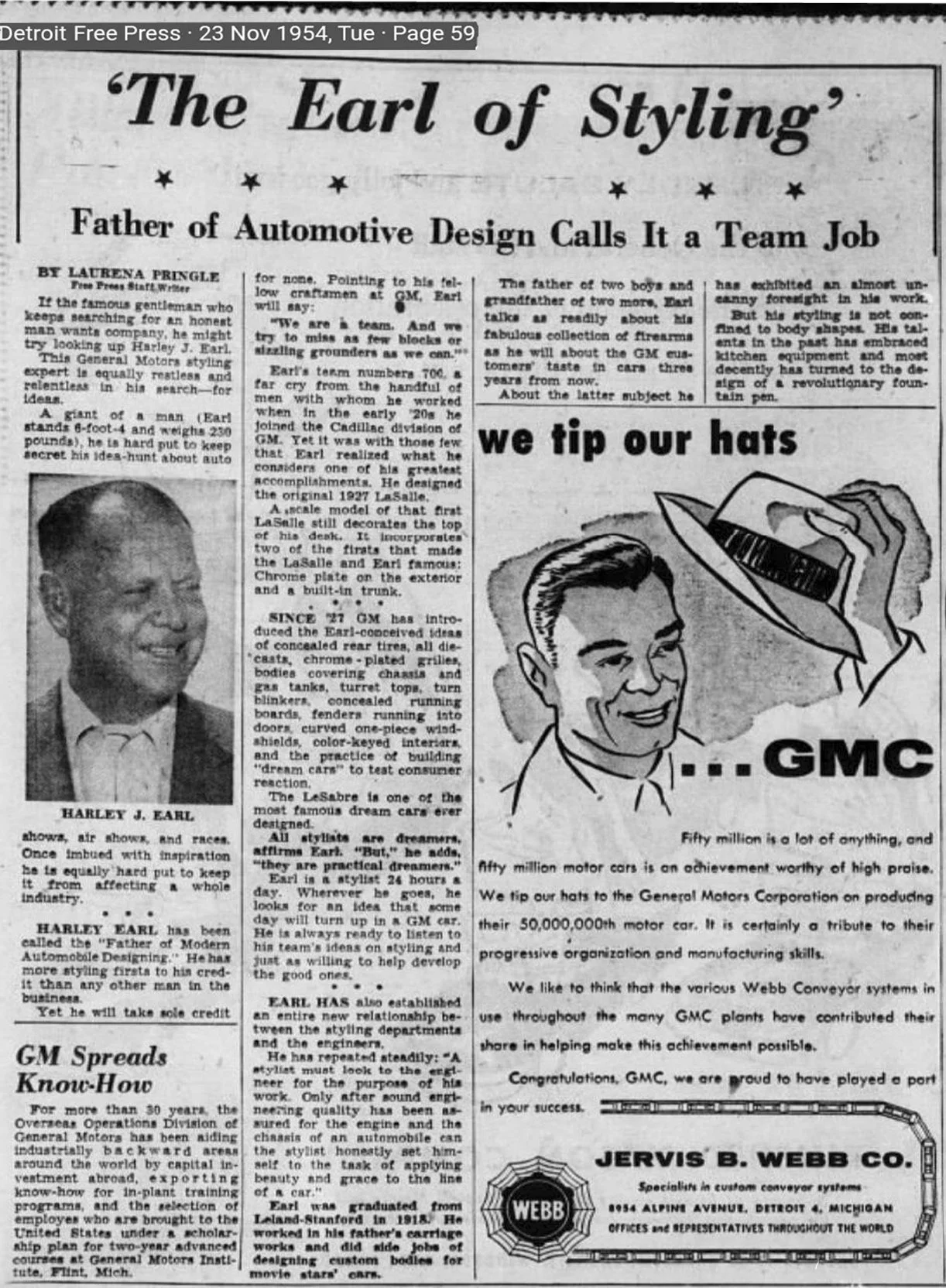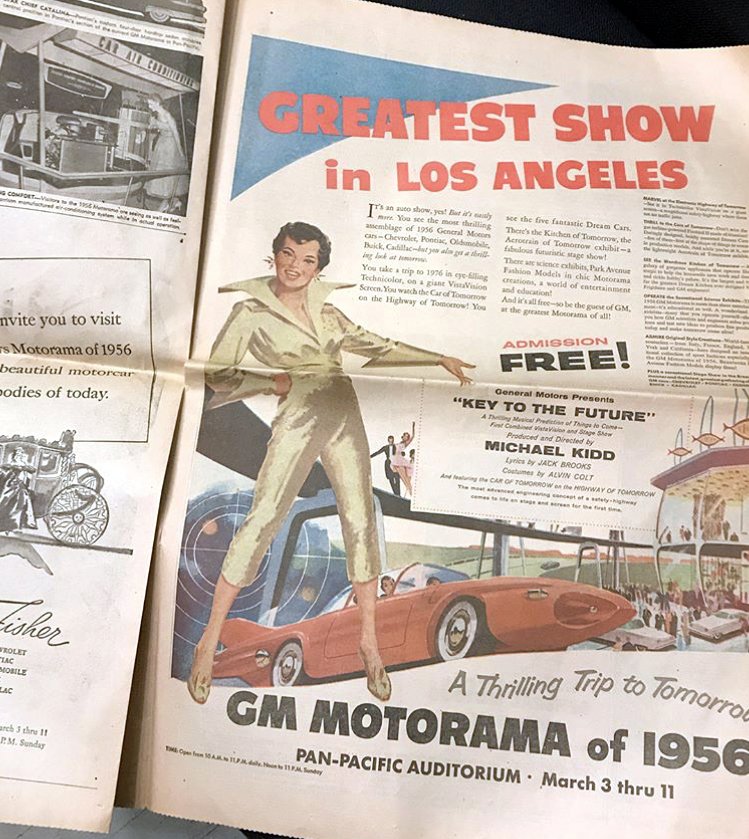Notice Innovator-Earl placed a little red Le Sabre on book’s cover, (here’s the pdf).
“CHAIRMAN-OF-CHANGE”
Two months before this landmark book on modern auto making, at left, was released in May of 1956, a business writer, Carl Spielvogel, coined Harley J. Earl as an American “DREAMER-IN-CHIEF” in a March 25th New York Times article titled, Along the Highways and Byways of Finance, displayed further down.
Styling The Look of Things (here’s the pdf) began a whole new conversation on the evolution of the modern automobile. And it was in this period that GM’s managerial genius Alfred P. Sloan Jr. let the cat out of the bag on Harley Earl, “With the possible exception of Henry Ford, no other person has single-handedly contributed more to the evolution of the modern automobile industry.”
Introductory page has Harley addressing his favorite domain, “secrecy.”
Harley’s 75-page book covered all the bases on a remarkable journey of how car design and big business had first merged to create millions of amazing mid-century works of art and engineering by GM. At the time, HJE knew all about how the next leg of the GM adventure (10 to 15 years down the road) all the company’s transportation products would incorporate an onboard computer.
Even though the General’s vehicles were the epitome of modernity they still knew in the mid-50s how the company’s future rise would be all about embracing “high technology.” Of course, because of “secrecy” the last thing GM was ever going to do back then was “talk it up.”
There’s no disputing it, GM’s first modern R&D boss and/or Chairman-of-Change, Harley J. Earl, taught the rest of the auto world how to get their Hollywood showmanship and hi-tech game on moving into the future.
Originally, the book created a firestorm of controversy in and outside the auto capital. For example, powerful East Coast “product designers” sided with Raymond Loewy’s high-minded industrial design thinking. Loewy had just written a scathing Atlantic magazine article in 1955 titled, “Jukebox on Wheels” criticizing Earl’s entire modern car design philosophy taking place in the mid-West. Long time car designer Homer LaGassey said, “When Loewy’s article came out it was like a cannon shot over the bow of the American car industry.” It went on to create a giant rift between traditional product designers versus car stylists (a.k.a. car designers) employed by the Big Three. One newspaper reporter labeled HJ. Earl’s car stylists as, “the Earlites.”
Harley Earl and his top “Stylists” laughed off the article as “professional jealousy” since their emerging new “auto design profession” was the biggest cash cow, uninterrupted over the last two decade in a row, (in numbers, stats and finance) under the entire industrial design umbrella. It’s hard to beat that kind of proof.
This 1954 magazine ad exposes Loewy stating he was the “World’s most famous designer.” Maybe this declaration was true inside New York City circles?
Loewy and his faithful members of the Industrial Designers Society of America didn’t change going into the 1960s and loathed Detroit’s car stylists — they were Loewy’s No. 1 business enemy.
Much of the turmoil can be traced to all the positive press Detroit’s auto world was receiving in the national headlines. One report inside a 1955 Industrial Design magazine issue, with a feature article titled “Design In Detroit,” must have surely made Loewy’s high minded blood boil, “Detroit is the design capital of the U.S.A.”
In any event, every major auto competitor — in the world — started following GM’s new business direction, i.e., creating an exact duplicate Auto Design department in their respective company. Coming out of the war years was the time when these giant car companies started doing pirating raids and paying top dollar to get Harley’s “GM car stylists” to jump ship and bring what they knew, and certain auto design technology, with them on exiting H.J. E’s Styling Section of GM and moving to rival auto maker.
After all, Harley’s Styling The Look Of Things book became standard equipment (and “the pages began falling out by the end of 1960s because these booklets were referenced so often” one car designer mentioned) in all the brand new car design studios of not just Toyota, Nissan, Honda but Porsche but Mercedes Benz, too.
This was a time in history when everyone who was anyone in Detroit’s auto business knew exactly how big a role Harley’s new math-based “Car Design” profession had played in making GM the crown jewel of the entire business world before, during and after WWII.
All rivaling auto manufacturers of GM were shown that “Harley’s new profession of car design” was the way forward to build modern autos to sell. And as over-the-top as it may sound now, some 70-years later, not much has changed for every major car company around the globe today still follows this exact pattern and process of auto & truck product design/engineering Harley initiated inside GM, first. In many respects Car Design is the heart and soul of modern car building today. How cool is that!
If you dig a little deeper, you’ll discover that within a decade of time from when this Styling The Look Of Things boo was released in 1956, the — car — that used to be hyped as “A Car For Every Person” had mushroomed exponentially into what most of the masses understood and that was how the — car — had grown up and become the world’s most adored consumer product, along with being, the most important purchase people would make in their lifetime second only to buying a home…not just in America, but throughout the free world!
There’s no getting around it, H.J. Earl was, is and will always remain America’s “Car Design Pioneer.” That’s exactly how the Detroit Free Press reported it in 1954, notice above pictured news story title, and the Detroit News headlined this man’s April 10, 1969 obituary: HARLEY J. EARL DIES; CAR DESIGN PIONEER
On a cold May 16th day in 1956, 5,000 business leaders descended on the brand new outrageous $100,000,000 million dollar GM Tech Center to attend the dedication ceremony in Warren, Michigan. Every person that day was handed a copy of, “Styling The Look Of Things.”
KEY TO THE FUTURE
Photo above shows GM’s President Harlow Curtice having just stepped out of the radical new Firebird II concept car. This was the world’s first autonomous car. Harley fabricated the experimental car body out of the wonder metal, titanium. GM debuted the motoramic masterpiece with its all-new advanced driving technology to the public, in select cities across the nation, and practically everyone was mesmerized by this American super car at the Motorama Shows.
Harley and his team also had a lighthearted Hollywood color movie made for the general audiences of the 1956 Motorama Shows titled, Key To The Future and over 2-million people saw the movie while attending these lavish GM events that were free.
Firebird II was not only the very first car with a computer inside it, but perhaps more importantly — concerning today’s worldwide efforts — this remarkable American car introduced a coast-to-coast “autonomous car” driving idea dubbed the, Safety Highway of Tomorrow (you can see the new technology at the above link).
It was the vision of GM’s Dream Team, but the trailblazing pioneer behind the concept was once again H.J. Earl. Knowing the historical importance, he patented the idea.
1956 Firebird II and HJE at GM’s Desert Proving Grounds in Mesa, Az. The first car with a computer!
Harley and the rest of GM’s top team truly were the first modern business leaders to envision how one day, millions of people would be happily traveling on America’s super autonomous highways of tomorrow.
Just like baseball and apple pie, the untold story of the mid-twentieth century GM dream team is an American Original.





